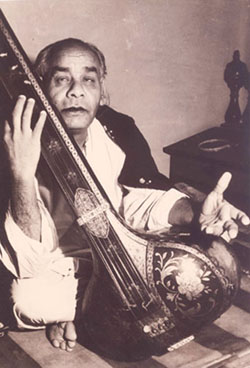Ancient North Indian Classical Vocal

Dhrupad is perhaps the oldest style of classical singing in north Indian music today. The heyday of this style was in the time of Tansen. It is a very heavy, masculine style known for its austere quality and strict adherence to the tal. The moods of dhrupad may vary, but themes revolving around the victories of great kings and mythological stories are common. Devotional themes are also very common.
The dhrupad usually adheres to a four-part structure of sthai, antara, abhog, and sanchari. It is usually set to chautal of 12 beats, tivra of 7 beats, or sulfak of 10 beats. Occasionally one hears matt of 9 beats, or farodast of 14 beats. Its formal structure makes it a very difficult style to master. Unfortunately, this rigidity has also made it very difficult for the average person to appreciate. Today this style is almost extinct.
There are a number instruments which are used to accompany dhrupad style of singing. The tanpura is the ubiquitous source of the drone, as it is in almost all classical music. The pakhawaj is the preferred rhythmic accompaniment. Although dhrupad, like dhammar. does not require any more than this, one sometimes finds rudra vina, sursringar, or seni rabab used as accompaniment.
Both dhammar and dhrupad share a curious relationship between the pakhawaj and the main performer. In the majority of North Indian classical music, it is the responsibility of the tabla to be the timekeeper. However the pakhawaj is generally not the timekeeper for dhrupad. Therefore, in traditional performances there is no theka as we would normally think of it. A similar relationship exists between the mridangam and main performer in Carnatic music.
Dhrupad is also an instrumental form. However as an instrumental form, it is a mere imitation of the vocal dhrupad
Selected Video
| THESE BOOKS MAY NOT BE FOR YOU |
|---|
A superficial exposure to music is acceptable to most people; but there is an elite for whom this is not enough. If you have attained certain social and intellectual level, Elementary North Indian Vocal (Vol 1-2) may be for you. This has compositions, theory, history, and other topics. All exercises and compositions have audio material which may be streamed over the internet for free. Are you really ready to step up to the next level? Check your local Amazon. |
Other Sites of Interest
Women as a Proposition to Explicit the Esthetic Values of North Indian Classical Vocal Music
Multiple Viewpoint Modeling of North Indian Classical Vocal Compositions
Sonic Performativity: Analysing Gender in North Indian Classical Vocal Music
Indian Classical Music: Tuning and Ragas
Modes and Ragas: More Than just a Scale
Emotional responses to Hindustani Raga music: The role of musical structure
Automatic Raga Recognition in Hindustani Classical Music
Patrick Moutal. A Comparative Study of Selected Hindustānī Rāga-s based on Contemporary Practice
Automatic Tonic Identification in Indian Art Music: Approaches and Evaluation
